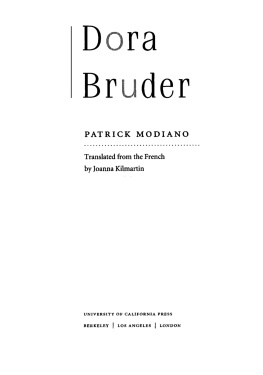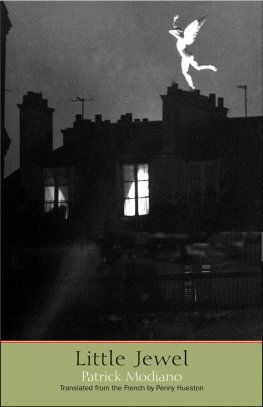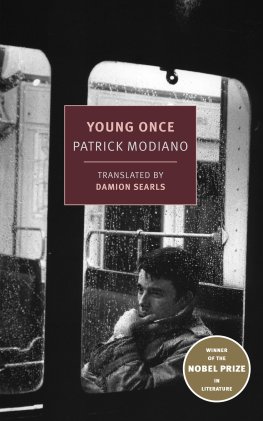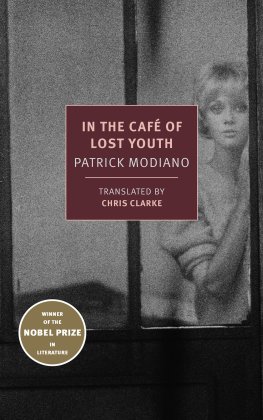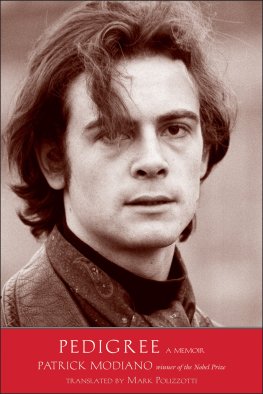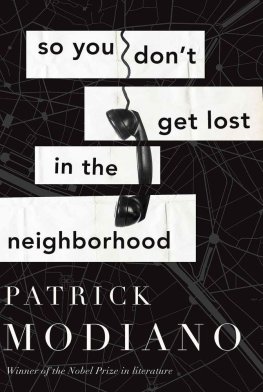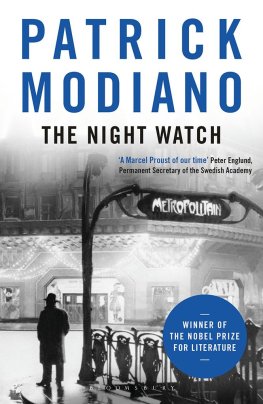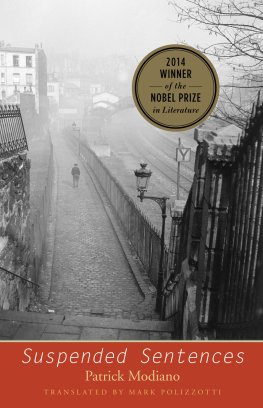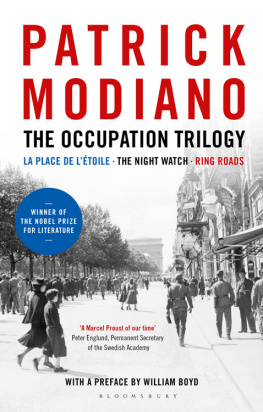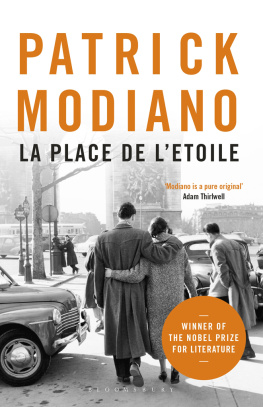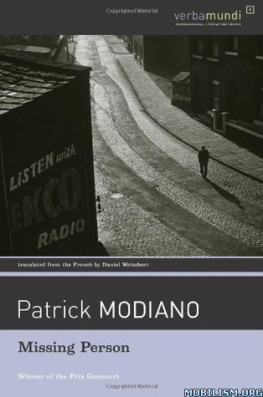 Dora Bruder with her mother and father
Dora Bruder with her mother and fatherDora
Bruder
PATRICK MODIANO
...............................................
Translated from the French
by Joanna Kilmartin
UNIVERSITY OF CALIFORNIA PRESS
BERKELEY | LOS ANGELES | LONDON
University of California Press, one of the most distinguished university pressesin the United States, enriches lives around the world by advancing scholarship in the humanities,social sciences, and natural sciences. Its activities are supported by the UC Press Foundationand by philanthropic contributions from individuals and institutions. For more information, visitwww.ucpress.edu
University of California Press
Oakland, California
1999 by The Regents of the University of California
Translation 1999 by Joanna Kilmartin
Originally published as Dora Bruder in 1997 by ditions
Gallimard, Paris. Copyright Editions Gallimard Paris, 1997
First Paperback printing, 2015
Library of Congress Cataloging-in-Publication Data
Modiano, Patrick, 1945
[Dora Bruder, English]
Dora Bruder/Patrick Modiano ; translated from the Frenchby Joanna Kilmartin.
p. cm.
ISBN 978-0-520-21878-9
eISBN 978-0-520-96202-6
1. Modiano, Patrick, 1945 . 2. Bruder, Dora,19261942? 3. Holocaust, Jewish(19391945). I. Kilmartin, Joanna.
II. Title.
PQ2673.O3Z46413 1999
940.53'18'092dc21
[b] | 98-33890
CIP |
Contents
The publisher gratefully acknowledges the contribution tothis book provided by the Literature in Translation Endowmentof the Associates of the University of California Press, whichis supported by a generous gift from Joan Palevsky.

XIIe Arrondissement (detail)

XVIIIe Arrondissement (detail)
................
Dora
Bruder
.................
E IGHT YEARS AGO, IN AN OLD COPY OFPARIS-SOIR DATED31 December 1941, a heading on page 3 caught my eye:From Day to Day. Below this, I read:
PARIS
Missing, a young girl, Dora Bruder, age 15, height 1 m55, oval-shaped face, gray-brown eyes, gray sports jacket,maroon pullover, navy blue skirt and hat, brown gymshoes. Address all information to M. and Mme Bruder,41 Boulevard Ornano, Paris.
I had long been familiar with that area of the BoulevardOrnano. As a child, I would accompany my mother to theSaint-Ouen flea markets. We would get off the bus either atthe Porte de Clignancourt or, occasionally, outside the 18tharrondissement town hall. It was always a Saturday or Sundayafternoon.
In winter, on the tree-shaded sidewalk outsideClignancourt barracks, the fat photographer with round spectaclesand a lumpy nose would set up his tripod camera among thestream of passers-by, offering souvenir photos. In summer,he stationed himself on the boardwalk at Deauville, outsidethe Bar du Soleil. There, he found plenty of customers. But atthe Porte de Clignancourt, the passers-by showed littleinclination to be photographed. His overcoat was shabby and hehad a hole in one shoe.
I remember the Boulevard Ornano and the BoulevardBarbs, deserted, one sunny afternoon in May 1958. There weregroups of riot police at each crossroads, because of thesituation in Algeria.
I was in this neighborhood in the winter of 1965. I had agirlfriend who lived in the Rue Championnet. Ornano 4920.
Already, by that time, the Sunday stream of passers-by-outsidethe barracks must have swept away the fat photographer,but I never went back to check. What had they been used for,those barracks? I had been told that they housed colonialtroops.
January 1965. Dusk came around six oclock to thecrossroads of the Boulevard Ornano and the Rue Championnet. Imerged into that twilight, into those streets, I was nonexistent.
The last caf at the top of the Boulevard Ornano, on theright, was called the Verse Toujours. There was another, onthe left, at the corner of the Boulevard Ney, with a jukebox.The Ornano-Championnet crossroads had a pharmacy andtwo cafs, the older of which was on the corner of the RueDuhesme.
The time Ive spent, waiting in those cafs... First thingin the morning, when it was still dark. Early in the evening,as night fell. Later on, at closing time...
On Sunday evening, an old black sports cara Jaguar, Ithinkwas parked outside the nursery school on the RueChampionnet. It had a plaque at the rear: DisabledEx-Serviceman. The presence of such a car in thisneighborhood surprised me. I tried to imagine what its owner mightlook like.
After nine oclock at night, the boulevard is deserted. I canstill see lights at the mouth of Simplon mtro station and,almost opposite, in the foyer of the Cinma Ornano 43. Ivenever really noticed the building beside the cinema, number41, even though Ive been passing it for months, for years.From 1965 to 1968. Address all information to M. and MmeBruder, 41 Boulevard Ornano, Paris.
Dhier aujordhui.
During the Occupation of Paris, Clignancourt barracks housed Frenchvolunteers in the Waffen SS. See David Pryce-Jones, Parus ub the Third Reich, Collins,1981.
Keep pouring, nonstop.
.................
F ROM DAY TO DAY. WITH THE PASSAGE OF TIME, I FIND,perspectives become blurred, one winter merging intoanother. That of 1965 and that of 1942.
In 1965,1 knew nothing of Dora Bruder. But now, thirtyyears on, it seems to me that those long waits in the cafs atthe Ornano crossroads, those unvarying itinerariesthe Ruedu Mont-Cenis took me back to some hotel on the ButteMontmartre: the Roma or the Alsina or the Terrass, RueCaulaincourtand the fleeting impressions I have retained:snatches of conversation heard on a spring evening, beneaththe trees in the Square Clignancourt, and again, in winter, onthe way down to Simplon and the Boulevard Ornano, all thatwas not simply due to chance. Perhaps, though not yet fullyaware of it, I was following the traces of Dora Bruder and herparents. Already, below the surface, they were there.
Im trying to search for clues, going far, far back in time.When I was about twelve, on those visits to the Clignancourtflea markets with my mother, on the right, at the top of oneof those aisles bordered by stalls, the March Malik, or theVernaison, there was a young Polish Jew who soldsuitcases... Luxury suitcases, in leather or crocodile skin,cardboard suitcases, traveling bags, cabin trunks labeled with thenames of transatlantic companiesall heaped one on top ofthe other. His was an open-air stall. He was never without acigarette dangling from the corner of his lips and, oneafternoon, he had offered me one.
Occasionally, I would go to one of the cinemas on theBoulevard Ornano. To the Clignancourt Palace at the top of theboulevard, next to the Verse Toujours. Or to the Ornano 43.
Later, I discovered that the Ornano 43 was a very oldcinema. It had been rebuilt in the thirties, giving it the air of anocean liner. I returned to the area in May 1996. A shop hadreplaced the cinema. You cross the Rue Hermel and findyourself outside 41 Boulevard Ornano, the address given in thenotice about the search for Dora Bruder.
A five-story building, late nineteenth century. Togetherwith number 39, it forms a single block, enclosed by theboulevard, the top of the Rue Hermel, and the Rue Simplon, whichruns along the back of both buildings. These are matching. Aplaque on number 39 gives the name of the architect, a mannamed Pierrefeu, and the date of construction: 1881. The samemust be true of number 41.

